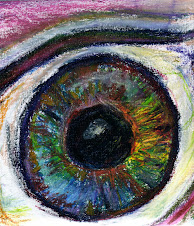 These are three scans taken from kindergarten albums from my family members. The first is carefully woven paper. It was made by Mary Edwards at Froebel Kindergarten in St. Louis City in the 1907-1908 school year. The other two scans were done by a boy, Albert Edwards, who attended kindergarten in the 1899-1900 school year, also in a St. Louis public school. The portrait of George Washington is a printed picture over which Albert has sewn very tiny neat straight stitches - the blue is a coarse thread and the white is a very fine thread. The holes are different sizes denoting that the needles were too. The third scan shows a series of folded origami.
These are three scans taken from kindergarten albums from my family members. The first is carefully woven paper. It was made by Mary Edwards at Froebel Kindergarten in St. Louis City in the 1907-1908 school year. The other two scans were done by a boy, Albert Edwards, who attended kindergarten in the 1899-1900 school year, also in a St. Louis public school. The portrait of George Washington is a printed picture over which Albert has sewn very tiny neat straight stitches - the blue is a coarse thread and the white is a very fine thread. The holes are different sizes denoting that the needles were too. The third scan shows a series of folded origami.

Why did I include these scans in the Eye Can Too! Read blog? I wanted to make a statement about what kinds of activities were done at the reading readiness, preschool level in the eras before television, plastic playgrounds, and Game Boys. The eye-hand coordination required to do any of these crafts is far more mature than we expect from fifth graders today, let alone from five year olds. Not only did these children have to demonstrate very fine motor control, this kind of close work would have strengthened their eye movements so that they could gain experience converging on near point images long before they were expected to use those eye movements to decode the meaning of text.





No comments:
Post a Comment